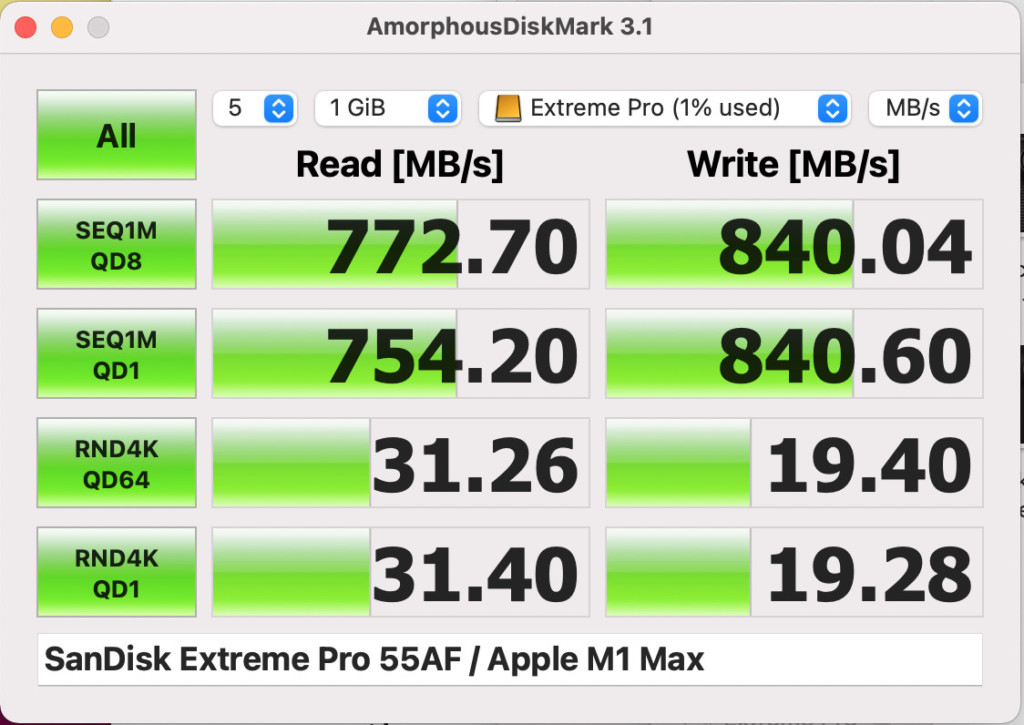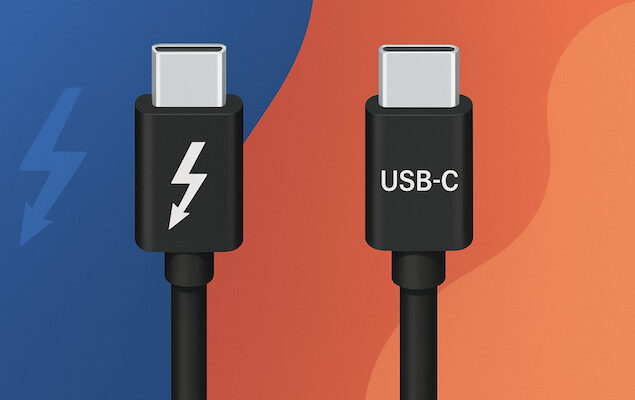If you’re confused by the increasingly complicated world of USB-C, USB 3.2 Gen 2×2, Thunderbolt 3, Thunderbolt 4 – and now Thunderbolt 5 – you’re not alone. Here we explain the real differences in speeds and standards, especially when using them with a Mac.
Whether you’re shopping for the best Thunderbolt external hard drive or a cheaper alternative to the Apple Studio Display, understanding how these connection standards differ can save you frustration – and money.
Table of Contents
Why This Matters for Mac Users
While Thunderbolt is relatively simple – it was co-developed by Intel and Apple – USB-C is much more confusing because of the many sub-standards (USB 3.0, 3.1, 3.2, Gen 1, Gen 2, Gen 2×2, USB4, etc.).
This has caused disappointment among Apple Silicon users who’ve purchased external SSDs claiming 2000MB/s speeds, only to see real-world results closer to 900–1000MB/s.
Below, we explain why that happens and how to choose the right drive or display for your Mac.
You May Also Like:
Bytes vs Bits: Understanding Speed Labels
Before diving in, remember:
- 1 byte = 8 bits
- 1 GB (Gigabyte) = 8 Gb (Gigabits)
Drive manufacturers often list speeds in MB/s (megabytes per second), while connection standards (like Thunderbolt) are rated in Gb/s (gigabits per second).
For example:
- 40 Gb/s = 5,000 MB/s (theoretical max)
- Real-world SSDs typically reach about 2,400–2,800 MB/s for Thunderbolt 3/4.
External drives have both a read speed (the time it takes to read data) and a write speed (the time it takes to write the data on the disk) which are usually similar but write speeds are often a bit slower.
So the SanDisk Extreme Pro SSD drive for example claims to offer transfer speeds of 2000MB/s via a USB-C standard known as USB 3.2 2×2 which equals 16Gb/s.
However, Mac users will get less than half these speeds with USB 3.2 2×2 connections as we’re about to explain.
What Is Thunderbolt?
Thunderbolt was created by Intel and Apple in 2011 to deliver high-speed data, video, and power over one cable.
Thunderbolt 3 & 4
- Speed: Both offer up to 40 Gb/s (≈5000 MB/s).
- Display support:
- Thunderbolt 3: 1 external 5K or 4K display minimum.
- Thunderbolt 4: Must support two 4K or one 8K display.
- Power delivery: Up to 100W.
- Cable lengths: Thunderbolt 3 may drop to 20 Gb/s on cables over 0.5m. Thunderbolt 4 maintains 40 Gb/s up to 2m.
- Daisy-chaining: Up to 6 devices.
- Security: Thunderbolt 4 adds Intel VT-d DMA protection.
All Macs since 2017 feature Thunderbolt 3 or newer, and all M-series Macs support Thunderbolt 4 or Thunderbolt 5.
In our tests, we’ve found that the fastest Thunderbolt external hard drives will deliver read speeds of around 2800MB/s and 2400MB/s write speed such as those achieved by the SanDisk G40.
Thunderbolt 5 (New in 2024–2025)
- Speed: Up to 80 Gb/s bidirectional or 120 Gb/s in “bandwidth boost” mode for video.
- Power: Up to 140W via docks.
- Display support: Up to three 8K displays with compression.
- Backward compatible with all Thunderbolt and USB-C standards.
Currently, Thunderbolt 5 is only available on M4 Macs and above such as the M4 Pro/Max MacBook Pros, M4 Mac mini (Pro) and the latest M5 MacBooks. No external drives yet support TB5, but expect the first ones to appear in late 2025 or early 2026.
What Is USB-C?
USB-C refers to the shape of the connector – not the speed.
It’s used across all modern Macs and PCs, but performance varies depending on which USB standard it uses.

However, the confusion starts when trying to understand the data transfer speeds you get with USB-C on a Mac (see more on this in USB-C designations below).
Because USB-C was not specifically designed for Macs like Thunderbolt is, the speeds that many PC users will get is different to the speeds Mac users will get.
USB-C Speed Standards Explained
Within USB-C there are now many different “designations” which offer different speeds which is where the confusion really starts for Mac (and many PC) users.
| USB Standard | Max Speed | Also Known As |
|---|---|---|
| USB 3.0 | 5 Gb/s | USB 3.1 Gen 1 / USB 3.2 Gen 1 |
| USB 3.1 Gen 2 | 10 Gb/s | USB 3.2 Gen 2 |
| USB 3.2 Gen 2×2 | 20 Gb/s | Dual-lane 10 Gb/s |
| USB4 | 20 or 40 Gb/s | USB4 Gen 2×2 / USB4 Gen 3×2 |
| Thunderbolt 3 / 4 | 40 Gb/s | Intel standard |
USB 3.2 Gen 2×2 on Macs
Drives like the SanDisk Extreme Pro V2 advertise up to 2000 MB/s via USB 3.2 Gen 2×2 (20 Gb/s). However:
- Macs don’t support USB 3.2 Gen 2×2.
Even the latest M4 Macs only support USB 3.2 Gen 2 (10 Gb/s) and Thunderbolt 4/5. - This means speeds are effectively capped at 1000 MB/s on macOS.
In short, you’ll get about half the advertised speed when using USB 3.2 2×2 drives on a Mac.
This is still pretty fast however and means you can transfer an 85GB file to a USB 3.2 2×2 external drive in just under 2 minutes and transfer it back to your Mac in around the same time.
In reality though, the read/write speeds will be even slower than this due to the way the hard drive throttles speeds to prevent over heating and the size of something known as the SLC cache.
It’s therefore possible that you’ll see transfer speeds of less than 1000 MB/s on an Apple Silicon Mac with a USB 3.2 2×2 external hard drive as you can see in the test results below.

Thunderbolt 4 vs USB 3.2 Gen 2
There’s a lot to take-in here so here’s a side-by-side comparison of how the USB-C 3.2 and Thunderbolt 4 standards compare.
| Feature | USB-C 3.2 Gen 1 | USB-C 3.2 Gen 2 | Thunderbolt 3 / 4 |
|---|---|---|---|
| Speed | Up to 5 Gb/s | Up to 10 Gb/s | Up to 40 Gb/s |
| Power Delivery | Up to 15W | Up to 100W | Up to 100W |
| Display Output | 1 × 4K | 1 × 4K | 2 × 4K or 1 × 8K |
| Daisy-Chaining | No | No | Yes (up to 6 devices) |
| PCIe Support | No | No | Yes |
| Security | None | None | VT-d DMA protection |
| Cable Length (Full Speed) | 2m | 2m | 2m (TB4 full speed up to 2m) |
| Backward Compatibility | USB 2.0/3.x | USB 2.0/3.x | USB4, USB 3.x, TB3 |
USB 4.0 Explained
USB4 finally unifies USB and Thunderbolt tech – at least on paper. It can reach 20 or 40 Gb/s, depending on the implementation.
However, USB4 support is optional for manufacturers, so devices vary widely in compatibility and speed.
Even Macs advertised as “USB4” won’t achieve 40 Gb/s with a non-Thunderbolt USB4 device – Apple limits 40 Gb/s to Thunderbolt connections only.
USB 4.0 vs Thunderbolt 4
USB 4.0 and Thunderbolt 4 can both achieve speeds of up to 40Gb/s.
They do not use the same technology though so you won’t be able to get 40Gb/s with a USB 4.0 device connected to a Mac.
This is because you can only get 40Gb/s with Thunderbolt on a Mac because Thunderbolt ports require an Intel controller in the external hard drive while USB does not.
So as with USB 3.0, 3.1 and 3.2, you can still connect USB 4.0 devices to a Mac but you just won’t enjoy the maximum transfer speed that it offers.
However, confusingly not all USB 3.0, 3.1, 3.2 or 3.2 2×2 standard supporting devices will work with USB 4.0.
It is entirely up to the manufacturer to make their USB 4.0 external drives or devices compatible with older USB-C standards and in some cases, they choose not to.
Note that sometimes Macs are advertised as “supporting USB 4.0” but as explained already, you won’t be able to get USB 4.0 speeds with them.
Thunderbolt 5
Thunderbolt 5 is yet another step-up from both Thunderbolt 4 and USB 4.0 supporting transfer speeds up to 120 Gbps in bandwidth mode and support for 8K displays.
Currently, the only Macs equipped with Thunderbolt 5 ports are M4 Macs such as the 2024 MacBook Pro models with the M4 Pro and M4 Max chips, as well as the new M4 Mac mini with the M4 Pro chip.
However, there are currently no external hard drives that support Thunderbolt 5 as yet.
To give you an idea how Thunderbolt 5 is a step-up from USB 4, check the comparison table below.
Thunderbolt 5 vs USB 4 Comparison Table
| Feature | Thunderbolt 5 | USB4 |
|---|---|---|
| Max Bandwidth | Up to 120 Gb/s (video mode) | Up to 40 Gb/s |
| Min Bandwidth | 80 Gb/s bidirectional | 20 or 40 Gb/s |
| Video Support | Up to 3 × 8K (DSC) | Dual 4K or 1 × 8K |
| Power Delivery | Up to 140W via docks | Up to 240W via PD |
| PCIe Support | Full PCIe 4.0 | Optional |
| Daisy-Chaining | Yes (up to 6 devices) | Limited |
| Backward Compatibility | TB4, TB3, USB4, USB3 | USB4, USB3, USB2 |
| Security | Intel VT-d DMA protection | Optional |
| Target Users | Pros, creators, gamers | General consumers |
Conclusion: Which Should You Choose?
If you want guaranteed top performance, always choose Thunderbolt drives or docks for your Mac.
- USB 3.2 2×2 drives like the SanDisk Extreme Pro will work – but you’ll only get ~1000 MB/s.
- Thunderbolt SSDs can reach 2,800–3,000 MB/s and support video output, daisy-chaining, and charging.
For professional video editors working in 6K or 8K, Thunderbolt is essential.
For everyday users backing up photos or editing 4K video, a high-quality USB-C SSD is still fast enough.
Key Takeaways
- Macs still don’t support USB 3.2 Gen 2×2 (20 Gb/s).
- All M-series Macs support Thunderbolt 4 or 5.
- Thunderbolt 5 brings 80–120 Gb/s speeds and triple 8K support.
- Always use certified Thunderbolt 4/5 cables for full performance.


